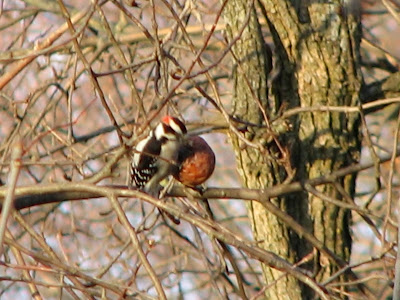I am so thankful for the abundance of apples we have at this little place here. DH and I are just in awe over the number of different types of apples we have growing wild. I am still trying to identify them; I'm convinced that some are not just wild sports but might actually be named heirloom varieties.
These are from a tree located on our north fence line on the edge of the pasture/hayfield,
and currently referred to as "the red pasture apple" until I find out exactly what kind it is.
Ripening late, and seeming to be very cold hardy, it is firm with white flesh.
They are pretty to look at, tasty to eat fresh, but unfortunately made rather a bland pie.
So, mark this tree for storage apples, or maybe cider; but not pies.
There is another tree, maybe 20 yards away, that is also a very late season apple, but it looks and tastes totally different. That one is a russet of some sort, with the characteristic yellow/brown coloration, flesh that is butter yellow and a very 'spicy' taste. That one we've marked as a contributor to future batches of cider.
This apple tree is on a different part of our north fence line. It is an early season apple, ripening in the summer, and if I remember right, it has a taste more like berries than apple. I suspect it might be what is called a "Strawberry" apple. Whatever it is, I want to try to harvest more apples from it in the future. They seem to have a very short time from ripe to rotten, and not at all a storage type.
Mostly, so far, the wild apple trees at this little place here have fed the wildlife more than they have the human population. As evidenced in this picture, where a very nice buck was snapped hanging out under one of the many apple trees where our woods meet our field.
And this squirrel, whom I watched climb the tree, carefully walk all the way to the very end of the branch this apple hung on, pick the apple, and climb down closer to ground level before enjoying the fruit of it's labor.
Even woodpeckers will eat the apples in the winter, not being put off at all by the brown, shriveled exterior of the mummified fruit.






No comments:
Post a Comment